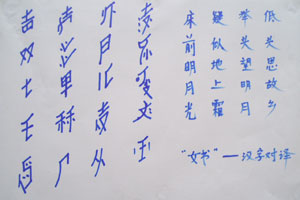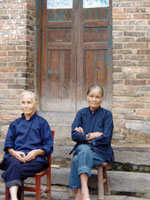China's oldest inheritress of the mysterious Nushu language, probably the
world's only female-specific language, died at her Central China home last
month. She was in her 90s.

A comparison
between Nushu (left) and standard Chinese
characters. |
Chinese linguists say the woman, Yang Huanyi, was the last woman who
possessed the most and genuine knowledge of a 400-year-old tradition in which
women shared their innermost feelings with female friends through a set of codes
that were incomprehensible to men.
Yang was born in Jiangyong County, where many people believe the language
originated. She learned to read and write the language as a little girl. Before
her marriage, she used to exchange letters in Nushu with Gao Yinxian, the eldest
of the seven sworn sisters of the county who were the local authorities on the
female-only language.
Though Yang herself did not join the sworn sisters, she did spend three years
with them to learn the language, and became its only surviving inheritress at
the end of the 1990s, after all the seven sisters had passed away.
Since then she had been dubbed a "living fossil of the women-specific
language" by linguists.
Until her death on September 20, it remained a mystery as to how old Yang
was. During an interview with Xinhua in the summer of 2002, she said she was 94.
Authorities in her hometown, however, said she was 98 when she died. Zhao
Liming, a specialist with Tsinghua University, said Yang was born in 1909.
It is often hard to tell the actual age of elderly Chinese people because
many are accustomed to giving their "nominal age," which is one to two years
ahead of the actual age. A baby's "nominal age" is considered to be one at birth
and becomes two at the beginning of the very next year.

Some elderly women,
including these two, in rural villages in Yongzhou of Central China's
Hunan Province, claim they have also learned some of the unique writing
scripts called Nushu. |
Yang was invited
to Beijing in 1995 to attend the United Nations Fourth World Conference on
Women. The letters, poems and prose she wrote were collected and compiled by
linguists of the Beijing-based Tsinghua University in a book that was published
earlier this year.
Linguists are trying hard to learn the language and experts say Yang's
writing was more standard, original and unaffected by Putonghua, or standard
Chinese or Han language, in which she was totally illiterate.
None of Yang's children or grand-children inherited her proficiency in the
unique language. The gracefully-written rhombic Nushu characters are structured
by just four kinds of strokes, including dot, horizontal, virgule and arc, and
can be spoken to describe women's misfortunes and inner feelings.
Some experts presume that the language is related to Jiaguwen - the
inscriptions on animal bones and tortoise shells of the Yin Ruins from more than
3,000 years ago - but no conclusions have been drawn as to when the language
originated.
Besides Hunan Province, the language was also used in some areas of southern
China's Guangxi Zhuang Autonomous Region. Nushu manuscripts are extremely rare
because, according to local custom, they were supposed to be burnt or buried
with the dear departed in sacrifice.
The language, among the first to enter the national list of China's ancient
cultural heritage, has aroused keen interest in worldwide scholars. At least 100
surviving manuscripts are abroad, according to archive keepers in Hunan
Province.
China has stepped up preservation of the language since the 1990s amid
assiduous efforts to better protect the country's traditional culture in an
increasingly globalized society.
The Hunan provincial archives have collected handkerchiefs, aprons, scarves
and handbags embroidered with Nushu characters, manuscripts written on paper or
fans, and calligraphic works.
"We have collected 303 artifacts bearing the rare language during five trips
to Yongjiang County, birthplace of the female language, over the past year,"
said Liu Gening, head of the provincial archives. "The oldest of them dates back
to the late Qing Dynasty in the early 1900s, and the most recent pieces are from
the 1960s or 1970s."
Among their collections are calligraphic works by Zhou Shuoyi, a retiree in
Jiangyong County who is believed to be the first man to learn the language in
China. Zhou, after half a century of study, compiled a Nushu dictionary last
year at the age of 79.
The dictionary, which contains all the 1,800 ancient characters of the
language, has complete stylistic rules, a layout with pronunciation, a glossary,
and grammar is arranged in international phonetic symbol order. Each Nushu
character is followed by a phonetic description, notes, a corresponding Chinese
character and example sentences.

